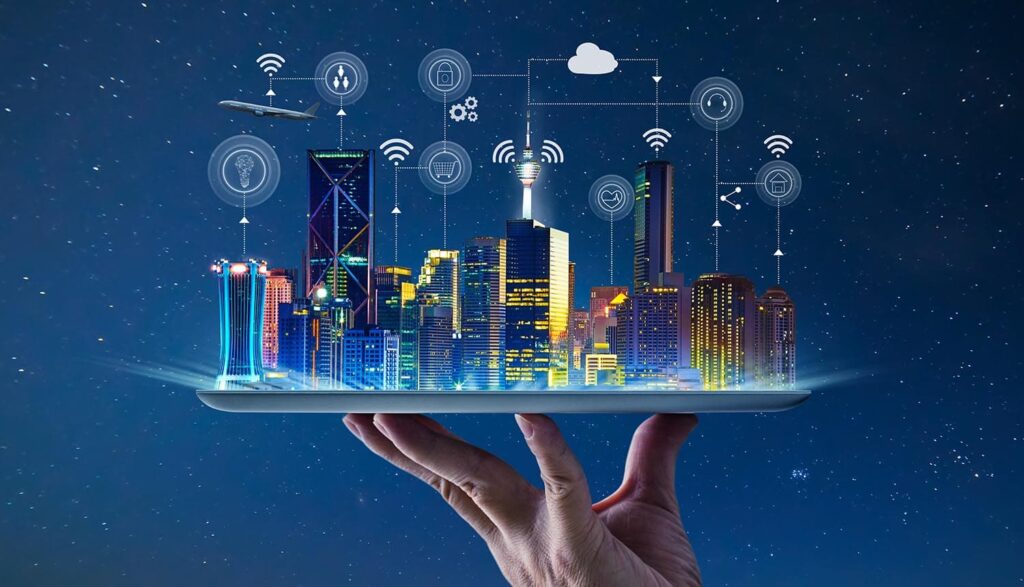Telematics plays a crucial role in the development and functioning of smart cities by enhancing connectivity, improving transportation systems, optimizing resource management, and promoting sustainable practices. Here’s a detailed look at the role of telematics in smart cities:
Improved Traffic Management
Real-Time Traffic Monitoring:
- Telematics systems provide real-time data on traffic flow, congestion, and incidents. This data can be used by city traffic management centers to monitor and manage traffic conditions effectively.
- Advanced analytics can predict traffic patterns and suggest optimal routes, reducing congestion and improving overall traffic efficiency.
Adaptive Traffic Signals:
- Traffic lights equipped with telematics can adjust their timing based on real-time traffic conditions, prioritizing movement on busier routes and minimizing wait times.
- This leads to smoother traffic flow and reduced idling time, which lowers vehicle emissions and fuel consumption.
Enhanced Public Transportation
Dynamic Scheduling:
- Telematics can optimize public transportation schedules based on real-time passenger demand and traffic conditions. Buses and trains can be dispatched more efficiently, reducing wait times and improving service reliability.
- Dynamic scheduling ensures that public transportation services are better aligned with the needs of commuters.
Fleet Management:
- Public transportation fleets can be monitored and managed using telematics, ensuring timely maintenance and reducing breakdowns.
- Real-time tracking of public transportation vehicles allows passengers to access accurate arrival times and plan their journeys more effectively.
Smart Parking Solutions
Real-Time Parking Information:
- Telematics can provide real-time information about available parking spaces, reducing the time drivers spend searching for parking.
- Smart parking systems can guide drivers to the nearest available spots, alleviating congestion in busy urban areas.
Efficient Parking Management:

- Data collected from parking sensors can be used to implement dynamic pricing based on demand, encouraging turnover in high-demand areas and ensuring better utilization of parking spaces.
- Improved parking management enhances urban mobility and reduces traffic congestion caused by drivers searching for parking.
Enhanced Safety and Emergency Response
Accident Detection and Response:
- Telematics systems can detect accidents and immediately notify emergency services, providing them with precise location data and reducing response times.
- Integration with city infrastructure allows for coordinated responses to emergencies, improving overall safety.
Monitoring and Enforcement:
- Telematics can be used to monitor compliance with traffic regulations and enforce laws, such as speed limits and red-light violations.
- Enhanced enforcement capabilities contribute to safer road conditions and reduce the incidence of traffic violations.
Environmental Sustainability
Reduction in Emissions:
- By optimizing traffic flow and reducing congestion, telematics helps lower vehicle emissions and fuel consumption.
- Encouraging the use of public transportation through improved reliability and convenience further contributes to reduced carbon footprints.
Sustainable Urban Planning:
- Telematics data can inform urban planning decisions, ensuring that infrastructure development supports sustainable transportation modes and reduces environmental impact.
- Smart city initiatives can leverage telematics to promote electric vehicle (EV) usage and manage EV charging infrastructure efficiently.
Enhanced Mobility Services
Ride-Sharing and Carpooling:
- Telematics enables efficient ride-sharing and carpooling services by matching drivers with passengers in real time based on their locations and destinations.
- These services reduce the number of vehicles on the road, leading to decreased traffic congestion and lower emissions.
Bicycle and Scooter Sharing:
- Telematics supports the management of bicycle and scooter-sharing programs, providing real-time location data and usage statistics.
- These programs promote the use of non-motorized transportation, reducing reliance on cars for short trips.
Infrastructure Management
Asset Tracking and Maintenance:
- Telematics can track the usage and condition of city infrastructure assets, such as roads, bridges, and public transportation vehicles.
- Predictive maintenance based on telematics data ensures timely repairs and extends the lifespan of infrastructure, reducing costs and improving safety.
Smart Grids and Energy Management:
- Integration of telematics with smart grids allows for efficient energy distribution and management, reducing wastage and optimizing resource utilization.
- Real-time monitoring of energy consumption patterns helps in managing demand and supply more effectively.
Data-Driven Decision Making
Urban Analytics:
- Telematics provides valuable data that can be analyzed to understand urban mobility patterns, infrastructure usage, and environmental impact.
- City planners and policymakers can use these insights to make informed decisions that enhance the quality of life for residents and promote sustainable urban development.
Citizen Engagement:
- Telematics data can be shared with citizens through mobile apps and online platforms, promoting transparency and encouraging public participation in urban planning and management.
- Engaged citizens are more likely to adopt sustainable practices and support smart city initiatives.
Conclusion
Telematics is a foundational technology in the development of smart cities, offering numerous benefits across traffic management, public transportation, safety, sustainability, and urban planning. By leveraging real-time data and advanced analytics, telematics helps create more efficient, safe, and sustainable urban environments. As smart city initiatives continue to evolve, the role of telematics will become increasingly integral to achieving the vision of connected, intelligent, and resilient urban centers.
